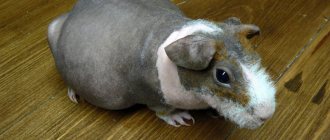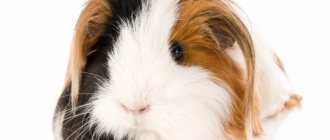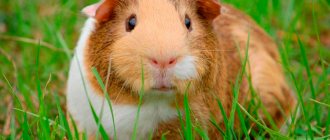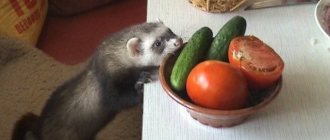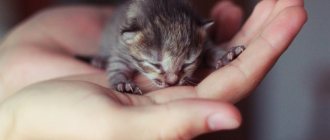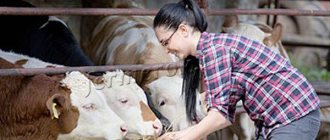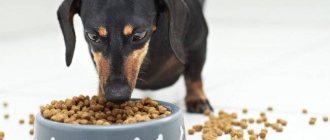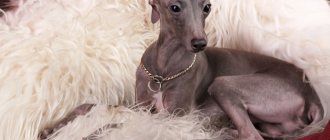Guinea pigs are considered unpretentious animals that do not require special living conditions. For their normal existence, they require a comfortable cage, a place to sleep, a feeder, a drinking bowl and the necessary food. But many do not know what to feed these animals. In almost any specialty store you can easily find special food for guinea pigs. But it is important that it contains the necessary level of useful components, vitamins, and minerals that are required for the full development and maintenance of the animal’s life.
Important feeding rules
In order for your pet to be healthy, cheerful and active, it is important to provide him with proper nutrition. In addition, the condition of the coat and teeth of these rodents depends on the diet.
The following types of products must be included in the daily diet:
- 20% dry feed mixtures;
- 20% juicy food;
- 10% green food;
- 50% hay.
In addition, you need to follow certain feeding rules that will help you maintain your pet’s health in good order:
- Many people often have the main question - how many times a day should you feed your guinea pig? Animals should be fed at least three times a day;
- You cannot remove food cups from the cage; the animal must always have food in the cage;
- There must be hay; a stand for it can be equipped almost immediately;
- If there are no dry food mixtures on the menu, then the portion of fresh vegetables and herbs should be increased to 150 grams per day;
- Food should be varied. It should include a variety of fruits and vegetables every day;
- An ideal daily serving should contain three different vegetables and herbs;
- Grasses for feeding guinea pigs should not be picked near roadways or in factory areas;
- Before lunch it is worth giving fruits, and after lunch you can already give dry food mixtures.
It is important to feed your guinea pig regularly; it should not go hungry. It has been established that if an animal has not eaten for more than 18 hours, then it needs to be euthanized, because irreversible processes begin in its body. An empty stomach causes a complete stop of intestinal activity.
What to do if your guinea pig gives birth
Preparation for the birth of a mumps begins long before it begins. Experienced rodent owners begin the process by planning mating.
In order for future cubs to enjoy good health, the following nuances need to be taken into account:
- The optimal age for reproduction in females is considered to be 4–6 months, however, due to the high percentage of mortality during gestation (about 25%), there is no need to rush into this;
- in the process of choosing a “groom”, you should make sure that he does not have genetic diseases;
- the pair should be chosen from strangers so that the animals are not related to each other, which is fraught with a high risk of pathologies.
Important! Veterinarians recommend mating guinea pigs no more than 3 times.
-
4 times a year.
This is the optimal frequency that allows the female’s body to fully recover. Individuals that have:
- very small eyes, blindness or fatty streak around the eyelids;
- malocclusion;
- weight that is deviated from the norm (guinea pig is too fat or thin);
- exoparasites.
Usually, the results of a meeting between a pair of animals can be expected on days 65–72, but the first harbingers of pregnancy become clearly visible after 4 weeks - the female becomes visually rounder.
Preparing a cage for keeping animals
Before the birth of the offspring, the cage should be pre-prepared, since after birth the babies will be near their mother for four weeks.
We recommend learning how to play with guinea pigs.
To do this, you need to remember a few rules:
- the male is sent to another cage in advance (approximately on the 50th day of pregnancy) - this is not caused by the desire to protect the newborns, but rather to ensure the peace of the mother;
- the cage itself is thoroughly cleaned every three days, and additionally treated with an antibacterial spray;
- if the feeder wears out, replace it with a new one, and also add several drinkers;
- the floor of the cage is covered with soft fleece bedding about 8 cm thick;
- if there are several females, you can leave them together only if they get along with each other;
- The cage is equipped with a flooring made of fresh hay (can be replaced with a small cardboard box), which will protect the offspring in the first days from possible infections.
Pregnancy and childbirth
The gestation period in guinea pigs directly depends on how many cubs are expected - the fewer there are, the longer the gestation period. Litter activity begins several days before birth, and therefore the female guinea pig requires very careful handling of herself. Also during pregnancy, you should carefully monitor the health of the expectant mother.
Did you know? Repeated pregnancy in female guinea pigs can occur as early as two hours after birth.
It is especially necessary to pay attention to the following factors:
- Health - while bearing offspring, females are very susceptible to stress and become vulnerable to various diseases. Therefore, you need to ensure maximum peace for your guinea pig: reduce loud sounds or bright lights, keep it away from direct sunlight, and rarely pick it up.
- Nutrition and water consumption - females are very susceptible to toxicosis during pregnancy, and therefore can often refuse food and even drink. However, even short periods of forced starvation can cause not only a general deterioration in the animal’s health, but also its death. Therefore, at the first refusal to eat, you should immediately contact a veterinarian, who will prescribe medications to alleviate the animal’s condition.
- A thorough examination - should be carried out every two weeks and should include certification of the absence of symptoms of various diseases (for example, thinning fur, stiff ears, etc.).
- Grooming procedures - during pregnancy, you should cut your guinea pig's hair as little as possible (and if the procedure is still planned, shorten the hair as much as possible) and completely avoid bathing, which is too stressful.
- Physical activity - the animal should be allowed to walk around the room on its own. This will help avoid obesity and blood stagnation.
An important factor for an easy pregnancy and the health of future offspring is a balanced diet, which should consist of:
- extruded granular food - its advantage over muesli is that the animal will not be able to choose the most delicious morsels and will receive more useful vitamins;
- clean water - in order for it to be constantly fresh, it must be changed at least once a day;
- high-quality hay - should consist of green hay (timothy or garden) with the addition of alfalfa, which contains a large amount of protein and calcium;
- fresh fruits - the female’s daily diet is supplemented with vegetables, the amount of which is 1.5–2 times more than the usual norm;
- sufficient vitamins - during pregnancy, guinea pigs suffer from a deficiency of vitamin C and calcium, which can be replenished with the help of special vitamin supplements.
Usually, a pig begins to give birth in the dark, and therefore it is extremely difficult to track the beginning. Babies appear at intervals of several minutes, but longer intervals are acceptable. During childbirth, you should not interfere with the process unless absolutely necessary.
You may find it helpful to read about pregnancy and childbirth in guinea pigs.
There are several signs that indicate that the female cannot give birth on her own:
- the duration of contractions is more than one hour;
- excessively strong screams of the female;
- drooling or foaming at the mouth;
- heavy bleeding (more than 1 tablespoon).
After the babies appear, you need to check if they are all breathing, and also make sure that the female eats the afterbirth and licks each child.
Requirements for dry food
Many pet stores sell a large variety of dry food mixtures that can be used for your guinea pig. However, the extensive range can cause confusion for many novice breeders of these rodents. For this reason, in order to choose the right dry food, you should pay attention to the following recommendations:
- You should not use mixtures every day that contain an increased level of fatty components (seeds, nuts), cellulose, sugar, or animal proteins;
- You can use food without dyes. Animals don't pay attention to different colors anyway;
- the composition of the feed should be balanced, cereals should predominate in it;
- the content of coarse fibers and vegetable proteins should be about 20%;
- Ascorbic acid (vitamin C) must be present in the composition.
If you wish, you can make your own dry food mixture; it’s quite simple. The composition must contain the following components:
- cereals;
- seeds;
- corn;
- legumes;
- dried fruits;
- dried vegetables;
- herbs.
What do newborn guinea pigs look like?
On average, one litter can contain from 1 to 6 individuals, however, in the case of the first pregnancy, there is a high probability that there will be only one baby. The initial weight of the animals can vary depending on their number, but usually does not exceed 100 g. Unlike other rodents, such as mice or rats, which are born blind and naked, newborn guinea pigs look like a smaller copy of their parents. Their abilities are truly amazing - after just a few hours, babies are able to run around the cage, and literally the next day begin to eat adult food.
Important! Despite all the features of independent babies, full development is ensured by being near the mother during the first month of life.
In addition, tiny animals immediately after birth have the following features:
- The animals' eyes are open and see well;
- hearing is initially acute - babies are frightened by sharp sounds;
- the wool is immediately present, but has a smoother and softer structure;
- teeth are formed;
- there are claws on the paws.
Green food
What else can you feed your guinea pig? You can include green food in your animal's diet. Moreover, the benefits of these food products are quite high:
- They are considered the natural food of rodents;
- Have a positive effect on the digestive organs;
- Replenishes the body's level of essential components and vitamins that ensure normal functioning.
However, it is worth considering that some plants can be poisonous; instead of being beneficial, they can, on the contrary, negatively affect the health of the pet. For this reason, it is worth studying in advance the list of permitted and beneficial green ingredients.
You can include the following green components in your diet:
- dandelion leaves and flowers;
- carrot and beet tops;
- clover;
- sprouted grain crops;
- yarrow leaves and stems;
- spinach leaves;
- dill stems;
- green salad leaves;
- plantain leaves;
- alfalfa;
- young sedge;
- chamomile;
- leaves of garden berries;
- celery leaves;
- mint leaves.
You can eat the above components at least every day. It is advisable to alternate them, thereby making your pet’s menu varied and healthy.
Hay
If you want your rodent to eat properly, be sure to include hay in its diet. This component is considered the most important; its content in the daily diet should be sufficient, namely at least 20%. It takes an active part in digestion, normalizes its functions, and ensures the grinding of teeth.
Hay can be purchased in many pet stores in ready-made form. But if you wish, you can prepare it yourself, especially since this will save costs. It takes about two months to dry, this must be done in a dry room without moisture.
Vegetables and fruits
Rodents can be given various types of vegetables and fruits. Their amount per day should be approximately 30% of the pet’s body weight. But it is best to give more vegetables, but leave fruit foods for later and give them as a treat.
It is worth considering that fruits contain high levels of sugar. When overeating this food, the animal may develop various diseases and disturbances in the functioning of many internal organs.
Below is a list of healthy vegetables and fruits that are given every day:
- carrot;
- pumpkin pulp and peel;
- cabbage – white and cauliflower;
- cucumbers;
- zucchini;
- corn cobs;
- apples;
- bell pepper;
- piglets eagerly eat rutabaga and turnips.
But which fruit or vegetable is better from the above is not so easy to answer, because each of them is useful in its own way. It is best to give three different vegetables and fruits every day. This will make the menu varied and richer.
Sometimes pets can be given the rinds and pulp of melons and watermelons. But you should not overfeed with these components, they are still very sweet. You can also sometimes treat your pet to plums, apricots, pears and peaches, but you should give them in limited quantities.
Development of cubs by day
Due to the initial presence of all the skills necessary for life in guinea pigs, further development after birth consists of gaining weight, increasing body size and strengthening internal organs.
We recommend reading how to properly care for a guinea pig.
At the initial stage there is rapid growth:
- on the second day of life, the cubs gain 1 g;
- starting from the third day, weight increases by 3-4 g daily;
- after 14 days, the initial body weight doubles;
- in the seventh week of life, the weight reaches 400 g, after which it begins to slow down.
The individual reaches full maturity at 6-7 months of life. During this period, body weight is 900–1200 g in males and 500–700 g in females. Moreover, the process of formation of internal organs lasts up to the 15th month of a guinea pig’s life.
Other food
If the pig has an active disposition, then high-calorie food should be included in its menu. In these cases, they can be fed with foods such as nuts, sunflower seeds, flax, and sesame seeds. But if the pet begins to quickly gain body weight, then these ingredients must be immediately removed from the menu.
You can also pay attention to the following products:
- Pigs can be given wheat bran, green peas, and some cereals;
- In order for rodents to replenish mineral reserves in their bodies, and also to ensure the grinding of teeth, it is recommended to give branches of fruit trees;
- Sometimes they can eat dried fruits. But you need to make sure that they eat them in small quantities. An excess of these components can negatively affect the health of the animal.
What foods should you exclude?
But many people often have a question: what should you not feed your guinea pig? After all, there really are foods that need to be completely excluded from a rodent’s menu. You can also tell about this to children who, unknowingly, may feed their pet a product that it should not eat.
So what should you not feed guinea pigs? Let's look at the types of forbidden foods:
- sweet;
- milk products;
- bakery products;
- pasta;
- Do not feed leftovers from the human table;
- rice;
- potato;
- salinity;
- smoked products;
- salad mustard;
- sorrel;
- horseradish;
- radish;
- burdock;
- mushrooms;
- garlic;
- chestnuts;
- green onions;
- products with increased protein levels.
Also, you should not give rodents branches of the following types of wood:
- oak;
- Rowan;
- buckthorn;
- willow;
- hornbeam;
- elm;
- sprigs of coniferous trees.
What is harmful for pigs?
Below we provide a list of foods, most of which are harmless in small quantities and do not contain many nutrients. And if you consume a large amount of such products, your pet may experience health problems.
Vegetables
Cabbage, namely white cabbage, Brussels sprouts and red cabbage. If you overfeed this product, your animal may experience severe flatulence and diarrhea.
Bulbs (green onions, leeks) are poisonous to guinea pigs.
Legumes can cause bloating in rodents, and in large quantities these products are toxic to pigs. But you can offer your pet some raw and fresh sprouts.
Potato. The tubers contain a large amount of starch, which is poorly digestible in its raw form, and the tops are poisonous.
Radishes and radishes have a strong taste and can cause irritation to the mucous membranes, so they are undesirable for these rodents.
Rhubarb contains a large amount of oxalic acid, which is poisonous for pigs.
Stone fruits - peaches, cherries, apricots, and plums contain large amounts of sugar and consuming them in large quantities can cause severe diarrhea.
You should also not feed your pet exotic fruits, as this will lead to digestive upset for the animal.
Animal products
Products of animal origin are contraindicated - milk, cottage cheese, butter, cream, meat, eggs, fish - since guinea pigs are vegetarians and do not eat such foods in their natural habitat.
Herbs
Some herbs are strictly contraindicated for guinea pigs, as they can lead to poisoning and even death of the animal. These herbs include:
- nightshade,
- dope,
- St. John's wort,
- belladonna,
- celandine,
- wolf berries,
- spurge,
- hemlock,
- night blindness,
- poppy,
- lily of the valley,
- henbane,
- marsh marigold,
- fighter,
- anemone,
- digitalis,
- veh poisonous,
- mustard,
- lumbago,
- hellebore,
- calligraphy,
- larkspur,
- buttercups,
- wild rosemary,
- wild and field radish,
- Avran officinalis,
- autumn colchicum,
- Kukol and others.
If you doubt what species a plant belongs to, then you should not risk the health or even the life of your pet; do not give it an unknown type of grass.
Indoor flowers
If you have a lot of flowers at home, then read the list of indoor plants that are poisonous to guinea pigs and put them away so that the animal does not get to them.
Poisonous indoor flowers for guinea pigs:
- cyclamen,
- anthurium,
- azalea,
- all types of milkweed,
- ivy,
- fatsia,
- Schefflera,
- alocasia,
- dieffenbachia,
- calla,
- zamioculcas,
- monstera,
- syngonium,
- spathiphyllum,
- caladium,
- philodendron,
- scindapsus,
- clivia,
- hippeastrum,
- oleander,
- nightshade,
- croton,
- asparagus,
- aloe,
- jasmine,
- ficus and others.
As you can see, most popular houseplants are poisonous to pets, so always make sure your pet doesn't accidentally eat any of the leaves growing on the windowsill.
Other
You should not feed your guinea pig sugar, chocolate, candy, honey, ice cream, cookies, marshmallows, marmalade and other sweets. Table salt in its pure form is not suitable for a rodent; it is better to offer your guinea pig a mineral or salt stone.
Also contraindicated for consumption are baked goods (bread, rolls, etc.), fried, salted, pickled, smoked, as well as boiled and baked products.
Branches, leaves and fruits of cypress, buckthorn, thuja, robinia, and yew are poisonous to guinea pigs.
Walnut branches can be given with leaves, but rarely, and the nuts themselves cannot be given. The situation is the same with chestnuts - branches can be offered to your pet occasionally, but chestnuts should never be given, they contain tannin.
But regarding oak, opinions differ - some believe that the branches of this tree should absolutely not be given to pigs, while others believe that it is possible, but rarely and in small quantities. But these rodents definitely can’t eat acorns because of the tannin they contain.
Also, you should not feed your guinea pig mushrooms, onions, garlic, sorrel, spinach, horseradish, salad mustard, raw or boiled cereals. Store-bought watermelons, cucumbers, herbs and tomatoes should not be used as pet food.
Regarding citrus fruits, there is an opinion that they can be given, but in very small quantities. Oranges, tangerines and grapefruits are peeled and filmed and given to the animals. Guinea pigs should not be given paper or foil.
Store-bought treats such as dried fruits, nuts, drops are also prohibited. Do not feed your pet from your table; he is not allowed soups, cereals and other human dishes.
Dry food for other rodents may use pellets containing fish oil, bone meal and animal fats, which is completely unsuitable for guinea pigs.
The list of foods that should not be fed to guinea pigs is quite extensive, and before offering your pet new food, look at what you should not feed to your guinea pig. Thanks to this approach to feeding your pet, you will protect him from unnecessary health problems.
Did you like the article? Share with friends: [supsystic-social-sharing id=”1"]
- Related Posts
- How to determine the sex of a guinea pig
- Do they bathe guinea pigs or how to properly wash your favorite pig
- Guinea pig colors
« Previous entry
Feeding a pregnant pig and newborn piglets
Be sure to carefully monitor the feeding of pregnant guinea pigs. The expectant mother should eat regularly. Her diet should have increased levels of vitamins and minerals. It is advisable at this time to include a large amount of sprouted grains of wheat, beets, carrots, and alfalfa.
It is also necessary to properly feed small guinea pigs if they are left without mother's milk. They need to be given 10% cream with a small amount of Linex powder. Every hour they need to be given a little, only 1 ml.
Add 1/10 of the contents of the Linex capsule to 1 ml of cream. the mixture is drawn into a syringe and given to the newborn baby, one drop at a time. From the second week, the offspring can already switch to adult food.
The main thing is to correctly follow all recommendations and feeding rules. Don’t forget about how many times you need to feed your guinea pig, what food you can give, and also don’t forget about forbidden foods. Despite the fact that these animals are not whimsical, food for them is an important component of a full-fledged existence.
Do I need to spay/neuter my guinea pig?
Many owners feel sorry for their small pets and, despite the considerable troubles caused by animals, do not dare to undergo sterilization surgery. However, in reality, such surgical intervention is not a complex procedure. Moreover, the animal fully recovers within a few days. The pet continues to live an ordinary life, delighting those around him with his calmness and kindness. Owners of guinea pigs that have undergone sterilization are satisfied. Because this makes their content much easier. Proper care and proper nutrition allows them not to gain extra pounds.
Advantages of sterilization:
- No need to control animal reproduction. A female will never become pregnant, even if she lives with a male in the same cage.
- Increasing the animal's life expectancy due to a reduced risk of developing sexually transmitted diseases and oncological pathologies.
- Pigs become good-natured towards not only people, but also other animals.
- No bad odors during heat.
When should surgery be performed on a female? It is recommended to sterilize a pig at the age of six months and weighing 600 g. In this case, the animal will better tolerate anesthesia and its rapid recovery.
